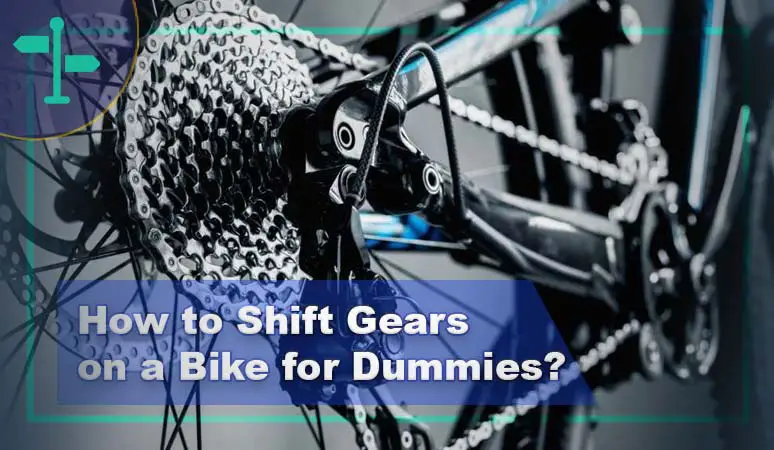It’s okay if you are not really understanding the whole bike gear shifting thing. At first, most of us were like that. The whole concept seems pretty impossible to grasp. But hang on there and don’t overwhelm yourself. Through some basic discussion, we can sort things out.
Today let’s talk about how to shift gears on a bike for dummies, those who are absolutely clueless with the topic. After the conversation, you won’t have to ignore the essential gear knowledge anymore. So, keep on reading…
All About How to Shift Gears on a Bike for Dummies
Unlike our writing on how to shift gears on a road bike shimano, we will be talking about bikes of other models as well in this discussion. From identifying gears to the actual shifting process, let’s talk both in today’s piece of writing. These both discussion in this serial is necessary if you want to get the fundamentals right. Here we go…

Know About Your Bike’s Gear First
Finding out whether your bike has multiple gears or not and then getting the exact number present is important. Let’s get that matter sorted first. At the very base of your pedals, you can count the number of gears.
You should see one or more than that number of metal rings on the center. The teeth should be outside and it would fit into chain. This is your bike’s front gears. Most common bikes have one to three front gears.
Now time to check the rear wheel gears. There should be a chain that goes right from the front gear. It should travel over various set of rings that stays on wheel’s center. These refer to rear gears basically and you need to count them.
A geared bike usually comes with more rear gears than front ones. There should be ten or even more than that. Now simply multiple both front and rear gear number. And this is your bike’s actual gear number. It is also known as speed to some people. A few more notes to take here are:are:
- Overlapping gear combinations can be seen in bikes that come with more than 8 gears.
- 1 gear bikes have one each at the front and rear. These are known as single speed bike.
- A single-speed bike cannot shift gears. Unless in the rear hub, there are some internal gears.
When You Are Starting or Stopping
When you start with the first few pedals, it’s usually the hardest of all. And that is because the bike goes from standing still to a certain speed. Starting with a fairly low gear shift can help you the most here. So that getting back to speed is simpler and trouble-free. If you face a red signal and need to completely stop, make sure to start with the low gear once again.
If you know that you’re going to pause the ride or stop it, shifting into low gear is a good thing to do. So that when you start again, it’s easier to pedal. This also works best when you are riding in tricky areas such as uphill.
Speeding Up
As you start riding faster and faster, the low gear will seem too slow and easier. So, to build the speed, you need to shift gear up. The pedaling will start to feel hard through to this and you’ll continuously accelerate.
For moderate terrain rides such as city roads or minor hills, go for middle gear. This works best for default cruising speed.
In Case of Riding on Hills
Beginners are often seen walking their bikes up to larger hills due to not having this very significant skill of shifting down. Lower gears will be your best bet to go up hills with less pace but more stability. And you don’t have to spend much effort to do so as well.
Low gear may feel a bit difficult to ride with because of the slow speed. Also due to the same reason, it may feel a bit trickier to maintain balance. But then again, the lower gear will help in getting foot quickly on ground whenever you feel like losing balance.
When Riding on Level Ground or Downhill Areas
For downhill or level ground areas, you must ride with shifting up. These are the types of terrain that works well with higher gears and speed settings. You will be able to accelerate steadily with shifting gear up gradually. However, this also means you can hurt yourself pretty quickly, so be careful.
Also, when you are shifting up, there’s a chance of hurting your joints. Pumping the bike in high gear may feel very exciting. But it may not be very good for your body. And especially for those who have knee troubles since this can put too much stress on joints. As a result, you may experience some soreness as well as long term joint issues. The best way to reduce these risks is by learning how to build up speed gradually with higher gears.
Avoid Gears That Cause Crisscross
If you pay attention to chains down there, you may notice that occasionally it points a bit toward the diagonal direction. This isn’t an issue until you are allowing gears that make angles too extremely diagonal. Over time, it will cause the chain to wear out easily as well as break in some cases.
Also, there are chances of slippage and rattling. The best way to avoid such troubles is by avoiding smallest and biggest gears in back and front. To cut it short, you must avoid bigger rear gears with the biggest front gear. And also prevent smaller rear with smallest front gear combination.
Watch This!
Wrap Up
And that were some basic ideas on how to shift gears on a bike for dummies and novice riders. You can practice the rules and keep these essentials in mind while learning more with passing time. Of course, the whole concept is still not covered entirely. But let yourself learn things slowly and eventually. That way you can make use of the most crucial factors without pressuring yourself with too much information.


